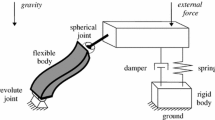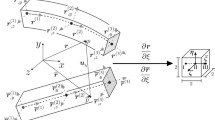Abstract
This paper discusses the generalization of the strain-split method (SSM) for the locking alleviation of curved structures. The generalization is achieved by using proper definitions of the stress and strain tensors along the curved-coordinate lines using the matrix of position vector gradients in the reference configuration. This matrix, which accurately captures the element geometry at the integration points, allows using consistent gradient transformation in the calculation of the stress and strain tensors. The generalized SSM implementation is used to verify the results and evaluate the performance of the absolute nodal coordinate formulation (ANCF) finite elements (FE). The focus of this study is on the Poisson locking that characterizes fully parameterized ANCF elements that employ different orders of interpolation in different directions. ANCF beam and plate nonlinear problems are presented, and the obtained simulation results are compared with analytical solutions as well as results obtained using commercial FE computer programs. These results are also compared with the results obtained using ANCF beam and curved plate elements in the case of nonzero Poisson ratio in order to demonstrate the SSM effectiveness in alleviating the Poisson locking. It is shown that a much smaller number of ANCF plate elements is required to achieve approximately 0.9% difference from the results of commercial FE computer programs.







Similar content being viewed by others
References
Bergan, P.G., Nygard, M.K.: Finite elements with increased freedom in choosing shape functions. Int. J. Numer. Methods Eng. 20(4), 643–663 (1984)
Choi, J., Lim, J.: General curved beam elements based on the assumed strain fields. Comput. Struct. 55(3), 379–386 (1995)
Dorfi, H.R., Busby, H.R.: An effective curved composite beam finite element based on the hybrid-mixed formulation. Comput. Struct. 53(1), 43–52 (1994)
Kim, J.G., Kim, Y.Y.: A new higher-order hybrid-mixed curved beam element. Int. J. Numer. Methods Eng. 43(5), 925–940 (1998)
Bonet, J., Wood, R.D.: Nonlinear Continuum Mechanics for Finite Element Analysis. Cambridge University Press, Cambridge (1997)
Ogden, R.W.: Nonlinear Elastic Deformations. Dover Publications, New York (1984)
Shabana, A.A.: Computational Continuum Mechanics, 3rd edn. Wiley, Chichester (2018)
Patel, M., Shabana, A.A.: Locking alleviation in the large displacement analysis of beam elements: the strain split method. Acta Mech. 229, 2923–2946 (2018)
Zheng, Y., Shabana, A.A., Zhang, D.: Curvature expressions for the large displacement analysis of planar beam motions. ASME J. Comput. Nonlinear Dyn. 13, 011013-1–011013-12 (2018)
Andelfinger, U., Ramm, E.: EAS-elements for two-dimensional, three-dimensional, plate and shell structures and their equivalence to HR-elements. Int. J. Numer. Methods Eng. 36(8), 1311–1337 (1993)
Armero, F.: On the locking and stability of finite elements in finite deformation plane strain problems. Comput. Struct. 75(3), 261–290 (2000)
Babuska, I., Suri, M.: Locking effects in the finite element approximation of elasticity problems. Numer. Math. 62(1), 439–463 (1992)
Babuska, I., Suri, M.: On locking and robustness in the finite element method. SIAM J. Numer. Anal. 29(5), 1261–1293 (1992)
Belytschko, T., Stolarski, H., Liu, W.K., Carpenter, N., Ong, J.S.J.: Stress projection for membrane and shear locking in shell finite elements. Comput. Methods Appl. Mech. Eng. 51(1–3), 221–258 (1985)
Carpenter, N., Belytschko, T., Stolarski, H.: Locking and shear scaling factors in \(C^{0}\) bending elements. Comput. Struct. 22(1), 39–52 (1986)
Hughes, T.J.R., Cohen, M., Haroun, M.: Reduced and selective integration techniques in the finite element analysis of plates. Nucl. Eng. Des. 46(1), 203–222 (1978)
Lee, P., Sin, H.: Locking-free curved beam element based on curvature. Int. J. Numer. Methods Eng. 37(6), 989–1007 (1994)
Noor, A., Peters, J.: Mixed models and reduced/selective integration displacement models for nonlinear analysis of curved beams. Int. J. Numer. Methods Eng. 17(4), 615–631 (1981)
Prathap, G., Bhashyam, G.R.: Reduced integration and the shear-flexible beam element. Int. J. Numer. Methods Eng. 18(2), 195–210 (1982)
Rakowski, J.: The interpretation of the shear locking in beam elements. Comput. Struct. 37(5), 769–776 (1990)
Raveendranath, P., Singh, G., Pradhan, B.: A two-noded locking-free shear flexible curved beam element. Int. J. Numer. Methods Eng. 44(2), 265–280 (1999)
Reddy, J.N.: On locking-free shear deformable beam finite elements. Comput. Methods Appl. Mech. Eng. 149(1–4), 113–132 (1997)
Schwarze, M., Reese, S.: A reduced integration solid-shell finite element based on the EAS and ANS concept—geometrically linear problems. Int. J. Numer. Methods Eng. 80(10), 1322–1355 (2009)
Simo, J.C., Armero, F.: Geometrically non-linear enhanced strain mixed methods and the method of incompatible modes. Int. J. Numer. Methods Eng. 33(7), 1413–1449 (1992)
Simo, J.C., Rifai, M.S.: A class of mixed assumed strain methods and the method of incompatible modes. Int. J. Numer. Methods Eng. 29(8), 1595–1638 (1990)
Simo, J.C., Armero, F., Taylor, R.L.: Improved versions of assumed enhanced strain tri-linear elements for 3D finite deformation problems. Comput. Methods Appl. Mech. Eng. 110(3–4), 359–386 (1993)
Stolarski, H., Belytschko, T.: Shear and membrane locking in curved \(C^{0}\) elements. Comput. Methods Appl. Mech. Eng. 41(3), 279–296 (1983)
Wriggers, P., Reese, S.: A note on enhanced strain methods for large deformations. Comput. Methods Appl. Mech. Eng. 135(3–4), 201–209 (1996)
Yunhua, L.: Explanation and elimination of shear locking and membrane locking with field consistence approach. Comput. Methods Appl. Mech. Eng. 162(1–4), 249–269 (1998)
Zienkiewicz, O.C., Owen, D.R.J., Lee, K.N.: Least square-finite element for elasto-static problems. Use of ‘reduced’ integration. Int. J. Numer. Methods Eng. 8(2), 341–358 (1974)
Zienkiewicz, O.C., Taylor, R., Too, J.M.: Reduced integration technique in general analysis of plates and shells. Int. J. Numer. Methods Eng. 3(2), 275–290 (1971)
Shabana, A.A.: Definition of ANCF finite elements. ASME J. Comput. Nonlinear Dyn. 10, 054506-1–054506-5 (2015)
Nachbagauer, K., Gruber, P., Gerstmayr, J., (2013) A 3D shear deformable finite element based on absolute nodal coordinate formulation. In: Multibody Dynamics: Computational Methods in Applied Sciences, vol. 28, pp. 77–96. Springer, Amsterdam
Yamashita, H., Jayakumar, P., Sugiyama, H.: Physics-based flexible tire model integrated with LuGre tire friction for transient braking and cornering analysis. ASME J. Comput. Nonlinear Dyn. 11(3), 031017 (2016). https://doi.org/10.1115/1.4032855
Romero, I.: A comparison of finite elements for nonlinear beams: the absolute nodal coordinate and geometrically exact formulations. Multibody Syst. Dyn. 20(1), 51–68 (2008)
Yakoub, R.Y., Shabana, A.A.: Three dimensional absolute nodal coordinate formulation for beam elements: implementations and applications. ASME J. Mech. Des. 123(4), 614–621 (2000)
Mikkola, A.M., Shabana, A.A.: A non-incremental finite element procedure for the analysis of large deformation of plates and shells in mechanical system applications. Multibody Syst. Dyn. 9(3), 283–309 (2003)
Dufva, K., Shabana, A.A.: Analysis of thin plate structures using the absolute nodal coordinate formulation. Proc. Inst. Mech. Eng. Part K J. Multi-body Dyn. 219(4), 345–355 (2005)
Bathe, K.J.: Finite Element Procedures. Prentice Hall, Englewood Cliffs (1996)
Mechanical, A.P.D.L.: Theory Reference. ANSYS release 16.2 (2018)
Author information
Authors and Affiliations
Corresponding author
Ethics declarations
Conflict of interest
The authors declare that they have no conflict of interest.
Additional information
Publisher's Note
Springer Nature remains neutral with regard to jurisdictional claims in published maps and institutional affiliations.
Appendices
Appendix A
Fully parameterized three-dimensional ANCF beam element
The fully parameterized three-dimensional ANCF beam element, proposed in [36], is a 2-node element with 24 degrees of freedom. The nodal coordinates \(\mathbf{e}^{jk}\) at node k of the finite element j are defined as
where \(\mathbf{r}^{jk}\) is the absolute position vector at the node k of the element j and \(\mathbf{r}_x^{jk} \), \(\mathbf{r}_y^{jk} \), and \(\mathbf{r}_z^{jk} \) are the position vector gradients obtained by differentiation with respect to the spatial coordinates x, y, and z, respectively. The shape function matrix can be written as \(\mathbf{S}=\left[ {s_1 \mathbf{I}\hbox { }s_2 \mathbf{I}\hbox { }s_3 \mathbf{I}\hbox { }s_4 \mathbf{I}\hbox { }s_5 \mathbf{I}\hbox { }s_6 \mathbf{I}\hbox { }s_7 \mathbf{I}\hbox { }s_8 \mathbf{I}} \right] \), where
where \(\xi =x/l\), \(\eta = y/l\), and \(\zeta = z/l\) are the dimensionless parameters of the element and l is the element length.
Fully parameterized ANCF thick plate element
The fully parameterized ANCF thick plate element, proposed in [37], is a 4-node element with 48 degrees of freedom. The nodal coordinates \(\mathbf{e}^{jk}\) at the node k of the finite element j are defined as
where \(\mathbf{r}^{jk}\) is the absolute position vector at node k of the element j and \(\mathbf{r}_x^{jk} \), \(\mathbf{r}_y^{jk}\), and \(\mathbf{r}_z^{jk} \) are the position vector gradients obtained by differentiation with respect to the spatial coordinates x, y, and z, respectively. The shape function matrix of this element can be written as \({\varvec{S}} =\big [s_1 \mathbf{I}\hbox { }s_2 \mathbf{I}\hbox { }s_3 \mathbf{I}\hbox { }s_4 \mathbf{I}\hbox { }s_5 \mathbf{I}\hbox { }s_6 \mathbf{I}\hbox { }s_7 \mathbf{I}\hbox { }s_8 \mathbf{I}\hbox { }s_9 \mathbf{I}\hbox { }s_{10} \mathbf{I}\hbox { }s_{11} \mathbf{I}\hbox { }s_{12} \mathbf{I}\hbox { }s_{13} \mathbf{I}\hbox { }s_{14} \mathbf{I}\hbox { }s_{15} \mathbf{I}\hbox { }s_{16} \mathbf{I}\big ]\), where
In this equation, \(\xi =x/a\), \(\eta =y/b\), and \(\zeta =z/t\) are the dimensionless parameters of the element and a, b, and t are the element length, width, and thickness respectively.
ANCF thin plate element
The ANCF thin plate element, proposed in [38], is a 4-node element with 36 degrees of freedom. The nodal coordinates \(\mathbf{e}^{jk}\) at node k of the finite element j are as follows:
where \(\mathbf{r}^{jk}\) is the absolute position vector at node k of the element j and \(\mathbf{r}_x^{jk} \) and \(\mathbf{r}_y^{jk} \)are the position vector gradients obtained by differentiation with respect to the spatial coordinates x and y, respectively. The shape function matrix of this element can be written as \(\mathbf S =\left[ {s_1 \mathbf{I}\hbox { }s_2 \mathbf{I}\hbox { }s_3 \mathbf{I}\hbox { }s_4 \mathbf{I}\hbox { }s_5 \mathbf{I}\hbox { }s_6 \mathbf{I}\hbox { }s_7 \mathbf{I}\hbox { }s_8 \mathbf{I}\hbox { }s_9 \mathbf{I}\hbox { }s_{10} \mathbf{I}\hbox { }s_{11} \mathbf{I}\hbox { }s_{12} I} \right] \), where
In this equation, \(\xi =x/a\) and \(\eta =y/b\) are the dimensionless parameters of the element, and a and b are the element length and width, respectively.
Rights and permissions
About this article
Cite this article
Shabana, A.A., Desai, C.J., Grossi, E. et al. Generalization of the strain-split method and evaluation of the nonlinear ANCF finite elements. Acta Mech 231, 1365–1376 (2020). https://doi.org/10.1007/s00707-019-02558-w
Received:
Revised:
Published:
Issue Date:
DOI: https://doi.org/10.1007/s00707-019-02558-w




